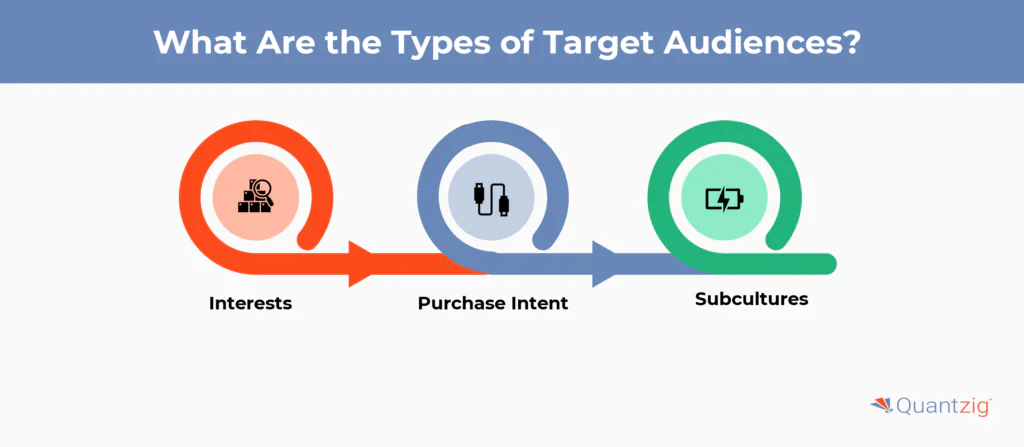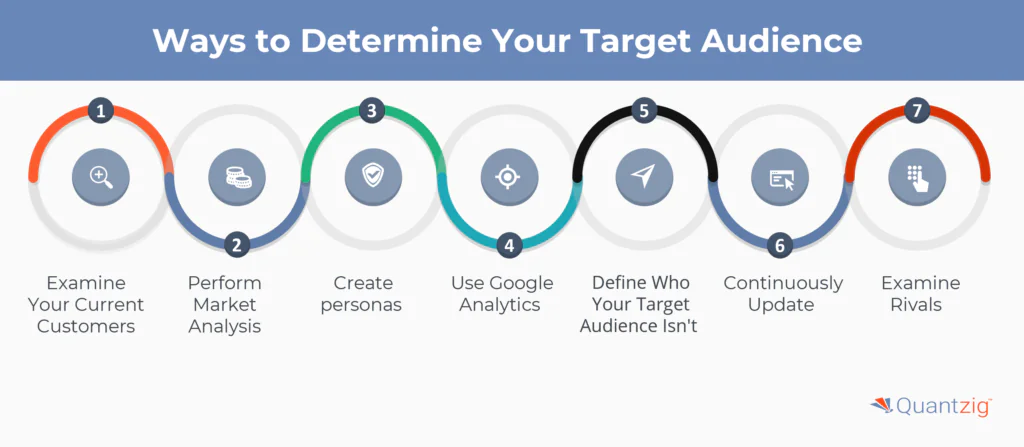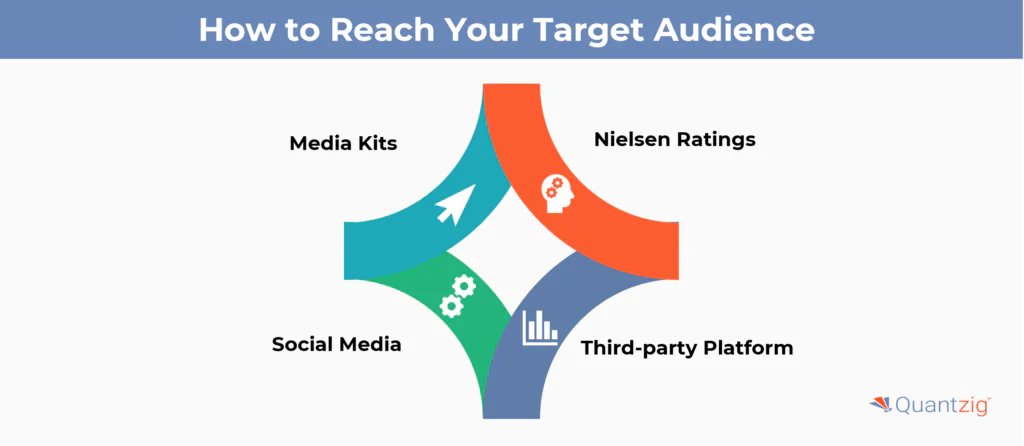Written By: Sudeshna Ghosh
Table of Contents
Key Takeaways for Audience Targeting Marketing
- Deep Understanding of Target Audience: Marketers must grasp their target audience’s demographics, interests, and behaviors to craft tailored marketing messages that resonate effectively. By defining a specific target audience, businesses can optimize their advertising efforts and achieve higher returns on investment.
- Importance of Targeting Precision: Targeting precision is paramount in maximizing marketing effectiveness and minimizing wasted resources. By leveraging advanced solutions such as AI and machine learning, businesses can analyze vast amounts of data to gain insights into consumer behaviors and preferences, enabling more accurate targeting.
- Strategic Media Selection: Choosing the right media outlets to reach the target audience is crucial for achieving marketing success. Whether it’s through traditional channels like magazines and television or digital platforms like social media, marketers need to align their advertising efforts with the preferences and behaviors of their target audience.
- Adaptation to Emerging Trends: Embracing emerging trends in audience targeting, such as privacy regulations, omnichannel marketing, contextual targeting, and immersive experiences through AR and VR, is essential for staying competitive in the evolving digital landscape. By staying abreast of these trends and integrating them into their strategies, businesses can forge deeper connections with their target audiences and drive better marketing results.
Introduction
The purchasing power now belongs to the customer, so marketers need to craft tailored, individualized experiences if they hope to capture people’s focus amidst the ocean of companies and promoters. When marketers thoroughly grasp who their perfect customer is, they can make smarter choices regarding media, messaging, and timing. We will examine what precisely a target demographic comprises, and the actions you can take to determine yours.
Book a demo to experience the meaningful insights we derive from data through our analytical tools and platform capabilities. Schedule a demo today!
Request a Free DemoWhat Is a Target Audience?
The target audience is the specific group of potential customers who are most likely to be interested in your product or service. Therefore, they are the group of people who should be exposed to your advertising campaigns. The target audience can be defined by demographics like age, gender, income level, geographic location, interests, or many other attributes. Your advertising should be directed toward your target audience, the consumers most probable to want to purchase what you are selling.
The size of your target audience will be determined by the type of product or service you are selling. If you have a broadly appealing product like shoes, your target audience will be wide-ranging since shoes are needed by men, women and kids. However, if you sell specialized products like high-performance running shoes, your target audience will be more niche – serious runners between 20-40 years old who actively participate in marathons and have expressed interest in running gear. Regardless, clearly defining and segmenting your target demographic is crucial for crafting marketing messages that resonate with them and identifying the channels they use and prefer. Carefully targeting your outreach helps ensure your brand connects with the right consumers and improve the marketing plans.
The Benefits of Knowing Your Target Audience
It is crucial for marketers to have a deep understanding of who they are trying to reach. This knowledge will shape every marketing campaign and tactic you implement. Placing an advertisement during the Super Bowl may seem like a great opportunity to get in front of a massive audience, but it is also very costly. Additionally, only about 25% of the viewers would actually be prospective customers for your product. Knowing the publications your target audience reads or the shows they watch means your ad will have less overall exposure, but it will reach the relevant people. For instance, if you market running shoes, ads in running magazines are likely a better avenue than the Super Bowl to connect with your target market. Choosing media outlets that align with your audience is key for achieving a return on your marketing investments.
Understanding who your target audience is allows you to not only boost your return on investment, but also forge connections and communicate better with customers. You can make advertising that speaks directly to specific buyer personas and create brands that align with the passions and ideals of those most inclined to buy what you’re selling. This is particularly crucial nowadays, when consumers anticipate all marketing to be customized and laser-focused on them. Indeed, 80% of shoppers say they are more prone to patronize a company that provides tailored interactions.
What Are the Types of Target Audiences?

Target audiences can be further segmented into categories based on things like interests, intent, location, and more. Here are some examples of ways to categorize your target audience:
1. Interests
You can separate groups by their various hobbies and entertainment preferences. This helps you create highly personalized, data-driven messaging to connect with your audience meaningfully and build brand loyalty.
2. Purchase Intent
You can define groups who are looking for a specific product like a new TV or car. This understanding of your audience’s pain points lets you craft tailored messaging that addresses their needs.
3. Subcultures
Subcultures are groups who share a common experience like music genres or being fans of something. Understanding your target audience’s motivations this way lets you better connect with who you want to reach.
By breaking down your target audience into categories like these, you gain valuable insights to craft messaging that resonates.
Also Read: Maximizing Marketing Budgets with Campaign ROI Analysis
Get started with your complimentary trial today and delve into our platform without any obligations. Explore our wide range of customized, consumption driven analytical solutions services built across the analytical maturity levels.
Start your Free Trial TodayThe Difference Between Target Audience and Target Market
Grasping the subtle difference between a target audience and a target market is vital for any business looking to optimize its marketing effectiveness. The target audience includes a defined group of people with common characteristics, behaviors, and interests, acting as the primary focus for tailored messaging and product positioning. In contrast, the target market encompasses a broader spectrum including not just the identified audience but also potential consumers who may display similar attributes or needs. While the target audience delineates the immediate demographic or psychographic market segmentation most likely to engage with a brand’s offerings, the target market reaches further, incorporating nearby segments that could possibly be tapped into with strategic marketing optimization efforts. Therefore, even though the target audience serves as the precise bullseye for focused targeting, the target market casts a wider net, enabling comprehensive market penetration strategies.
Understanding the Roles of Your Target Audience
Understanding the roles of your target audience is paramount in crafting effective marketing strategies that resonate with potential consumers and drive desired actions along the path to purchase. Through thorough market research and insightful client interviews, businesses can gain valuable insights into the demographic information and purchase intentions of their target audiences. By analyzing industry trends and leveraging the expertise of a Senior Content Marketing Manager, organizations can develop tailored approaches for audience targeting and implement programmatic advertising techniques to reach specific segments.
Moreover, considering device attributes and prioritizing user experience fosters personalization and ensures the delivery of relevant messaging to the right individuals at the right time. Strategic allocation of ad budgets based on audience insights and behaviors further enhances the overall effectiveness of marketing efforts, ultimately empowering businesses to connect with decision-makers and drive desired outcomes. These roles can frequently be separated into the following groups:
1. The Decision Maker:
This individual ultimately decides whether or not to make the purchase. Sometimes the decision-maker and the supporter are the same person, but other times they are distinct. When they are different people, you need to acknowledge this and tailor your marketing to the decision-maker. For example, consider Old Spice’s brand transformation in 2010. The company wanted to reinvigorate their product to appeal to a younger demographic. During their research, they found that while men wear their products, women were actually making the purchases. This led their creative team to focus their efforts on marketing to this target audience.
2. The Supporter:
It plays an influential role in the purchase decision even though they don’t have the final say. For instance, a child can’t buy something themselves but they can still impact the decision of what gift to buy them for Christmas. That’s why it’s crucial to craft messaging that resonates with people whether they are the direct purchaser or a supporter who sways the choice. This text maintains the original structure and meaning while using different vocabulary and phrasing.
Ways to Determine Your Target Audience

To identify your target audience, you need to dedicate time to examining the data you get from consumer interactions, studying current buyers and purchase trends, and adapting as new information comes to light.
The following steps should assist you in determining your target audience:
1. Examine Your Current Customers and Interview Clients
A great way to determine your target market is to analyze who already purchases your product or service – their age, location, interests, etc. This can be done by interacting on social media or sending out customer surveys.
2. Perform Market Analysis and Recognize Industry Patterns
Review market research for your industry to find service gaps your product can address. Examine trends for comparable products to see where they concentrate efforts, then focus further on the unique value of your product.
3. Create personas
Developing personas is an excellent method to examine the particular groups that make up your target market. This is especially beneficial if you have a product that interests a wide range of consumers. Personas enable you to identify the general demographics, characteristics and needs of your target customers. The persona of “Fran the Beginner Runner” will speak to different requirements than “Sam the Experienced Pro.” Personas are formed based on data, surveys, digital interactions and any other information marketers can utilize to provide a more comprehensive perspective of the buyers. This might consist of favored pastimes, television programs, publications, etc. It is advised that marketers create between three and five personas.
4. Use Google Analytics
Google Analytics provides comprehensive data about the people who visit your website. This data can be used to gain important insights like where your target audience is coming from and what content they interact with the most. Having this understanding allows you to make more informed, data-driven choices when planning your media strategy. The goal is still to reach the insights from the original text, just expressed differently.
5. Define Who Your Target Audience Isn’t
There will be consumers who are similar to your target demographic, but who will not respond to your messaging. Try to precisely determine who your audience is and who it isn’t. Is your target women in general, or women between 20 and 40 years old? Knowing this will prevent your teams from wasting ad money on segments that won’t generate returns.
6. Continuously Update
As you gather more data and interact with customers, you’ll gain an increasingly precise understanding of your target audiences. Using this information, you must constantly refine and hone personas to achieve optimal results.
7. Examine Rivals
Marketers can gain valuable insights by examining competitors to identify their target customers and marketing tactics. Do competitors utilize digital or traditional marketing channels? Do they concentrate marketing efforts on the key decision maker or influencer? By evaluating competitors’ customer profiles and go-to-market strategies, marketers can better understand the competitive landscape.
Also Read: Track Business Progress with Marketing Analytics Dashboard
Experience the advantages firsthand by testing a customized complimentary pilot designed to address your specific requirements. Pilot studies are non-committal in nature.
Request a Free PilotHow to Create Target Personas with The Right Demographics

We have already determined that developing personas is another excellent technique for comprehending target audiences. Combining market research and client interviews can provide greater insight into what your clients read, ponder, and cherish. This offers vital comprehension of the sources your audience utilizes and believes in. When constructing personas, think about utilizing the following demographics and identifiers:
- Age
- Gender
- Location
- Interests
- Salary
- Education level
- Job
- Marital status
- Who they have faith in
- What they read/view
Additionally, look into the following:
- Your current customer base
- Who your competitors are targeting
How to Reach Your Target Audience

Once you have developed personas, the next step is to find media content that is aimed at those specific groups. There are some resources below to help get you started:
1. Media Kits
Media kit information from publishers provides a clear picture of the audience segments they connect with. These can be segmented by job titles, income ranges, or hobbies depending on the publication. When deciding where to invest advertising money, marketers should make sure secondary audiences are not included in the totals. For instance, magazines are frequently passed on to friends and family after the initial reader is finished. This extended shelf life is good for marketers, but should not factor into decisions on where to advertise or negotiate costs. Use the number of paid subscribers when making choices and negotiating pricing.
2. Nielsen Ratings
Nielsen Ratings employs statistical sampling to estimate the number of households watching a particular show. While prime time may seem ideal for reaching a wide audience, you may find that more specialized programs in the early or late fringe attract your target market at a lower cost. This is especially true as the proliferation of channels and shows makes television increasingly fragmented.
3. Social Media
Social media enables ad targeting based on demographics and interests. Although highly precise, different groups engage with media differently. Some users may not respond to business ads on Instagram but may be more receptive on Facebook. It’s also crucial to assess the performance of various ad formats on these platforms, like display versus native. Testing across platforms reveals what drives results.
4. Third-party Platform
Marketing analytics platforms like the Marketing Measurement and Attribution Platform can assist in finding where your target audiences go or what TV shows they watch. When choosing a partner, look into how these companies figure out how to contact the target groups. Do they use old data or do they have partnerships with media companies?
How to Reach your Audience at the Right Time
In marketing to today’s empowered consumers, it is crucial to know not just where to reach them, but when as well. As consumers get better at ignoring marketing messages, communicating at the opportune time across channels will yield benefits.
There are a few key factors to think about for effective real-time marketing across different mediums:
1. Television
The advent of DVR has allowed viewers to skip commercials during recorded programs. As a result, even if your ad targets the right demographic, you can’t ensure it will be seen when placed in the middle of a commercial break. When buying TV ad time, try to get the slot right before or after a break. Even better are live events like late news or sports – since they are happening in real time, more people will see your ad rather than fast-forwarding through it. The key ideas are that DVR enables skipping commercials in recorded shows, so aim for ads placed around breaks or during live TV where fast-forwarding isn’t possible, to maximize viewership.
2. Radio
Radio listeners frequently change stations when commercials come on, so try to schedule your ads right when the break starts or ends if you can. Additionally, be aware of DMAs, or Designated Market Areas, which are determined by Nielsen based on signal power. For instance, the Boston DMA encompasses Rhode Island and southern New Hampshire along with the city proper. This is important to remember since radio can be an effective method for targeting local customers, but may also reach listeners outside the core area you want to focus on.
3. Email
When booking an eblast with an outlet, consider its timing. Fridays are a common day for people to take off, so sending an email out on a different day may increase your open rates (unless the data says otherwise).
4. Trends to watch in audience targeting
The dynamic nature of audience targeting is bringing about trends that will reshape strategies and improve marketing results. First, the growth of AI and machine learning is revolutionizing targeting accuracy, allowing businesses to analyze huge amounts of data to gain insights into consumer behaviors and preferences. Additionally, increased focus on privacy is necessitating ethical data gathering and transparent communication with audiences to build trust and loyalty. Moreover, the prominence of omnichannel marketing requires seamless integration across platforms and touchpoints to ensure consistent, personalized messaging. Furthermore, contextual targeting offers an alternative to cookie tracking by using content relevance to authentically engage audiences. Lastly, the ongoing development of AR and VR presents new ways to immerse audiences in customized brand experiences, improving engagement and conversion. Embracing these trends allows businesses to make deeper connections with target audiences and stay ahead in the evolving digital landscape.
How can Quantzig Help You with Audience Targeting Marketing?
Quantzig provides innovative data analytics solutions to assist companies in thoroughly examining and comprehending their target market. Using sophisticated methods like predictive modeling, machine learning, and AI-generated insights, we enable organizations to extensively analyze consumer demographics, actions, and preferences. By uncovering useful insights from huge data sets, our team allows businesses to improve their marketing plans, optimize targeting accuracy, and increase return on investment. With our proficiency in target audience analysis, companies can confidently customize their messaging, identify the most relevant channels for engagement, and eventually generate impactful business results in the current competitive environment.
Conclusion
In summary, being skilled at targeting marketing efforts towards a specific audience is vital for businesses looking to prosper in the highly competitive environment we see today. When companies comprehend the demographics, actions, and preferences of who they want to reach, they can create tailored marketing plans that genuinely resonate with that group. Utilizing advanced solutions like AI and machine learning allows for precise targeting, maximizing marketing success while minimizing wasted resources. Carefully choosing media channels that align with the audience’s preferences, along with adapting to emerging trends such as privacy regulations and omnichannel marketing, can further improve engagement and conversion rates. By adopting these principles and leveraging innovative analytics solutions like those provided by Quantzig, businesses can establish deeper connections with their target markets, make strong relationships with customers, and drive sustainable growth in the dynamic digital marketplace.


